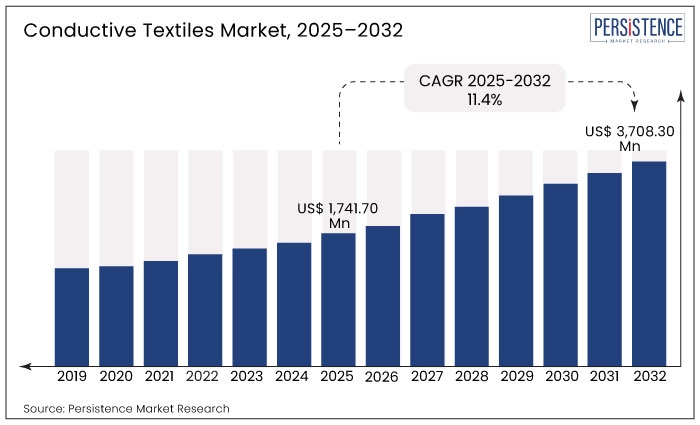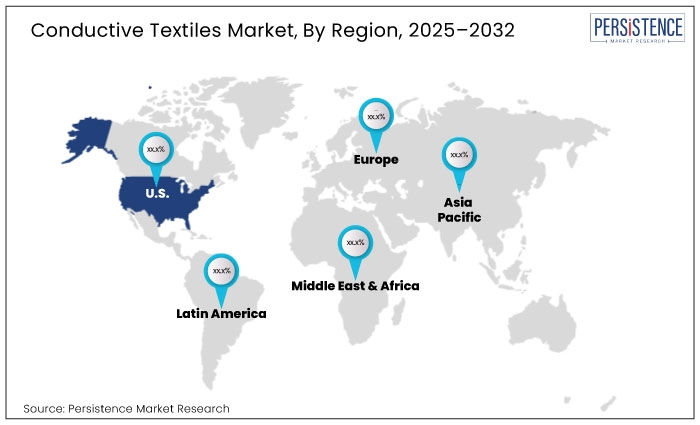ID: PMRREP33487| 210 Pages | 29 Jul 2025 | Format: PDF, Excel, PPT* | Chemicals and Materials

Global conductive textile sales are expected to total revenue of US$ 1741.7 million in 2025. Over the projection period, global demand for conductive textiles is projected to rise at 11.4% CAGR. By 2032, the global conductive textiles market size is projected to reach US$ 3708.3 million.
In 2024, the global conductive textiles industry was valued at US$ 1574.8 million. Demand remains particularly high for woven conductive textiles globally.
Key Market Shaping Factors:
Fabrics or textiles which can conduct electricity are known as conductive textiles. These textiles can be made either by depositing conductive materials onto non-conductive textiles or by simply using conductive fibers.
Conductive textiles are gaining wider popularity in applications such as smart textiles and e-textiles. They are used to control static and provide electromagnetic interference shield.
Initially, yarns of solid metals such as gold and silver were in conductive textiles. In the contemporary world, however, novel materials such as nanomaterials (e.g., carbon nanotubes and graphene) are gaining wider popularity.
Several companies are also showing interest in semiconductor textiles which are made by impregnating normal textiles with metal or carbon-based powders.
In recent years, conductive textiles have gained immense popularity on account of their excellent properties. They are being used across various sectors ranging from consumer electronics and healthcare to defense and sports.
Conductive textiles possess properties such as low weight, flexibility, high strength, durability, heat insulation, elasticity, etc. Few of the key uses of conductive textiles include EMI shielding, static dissipation, and signal & power transfer in low resistance versions.
Rising awareness about the superior functionality and application of conductive textiles is acting as a catalyst fueling their adoption and triggering their sales.
Conductive fabrics can help to avoid charge accumulation on a device or humans. They have the tendency to protect from electromagnetic waves or incendiary discharges that are potential health hazards.
Robust expansion of military and defense sector along with growing focus on improving safety of soldiers is forecast to create high demand for conductive textiles.
Conductive textiles are being increasingly used for making military uniforms that could improve the safety of soldiers in hostile environments. Usage of protective clothing made from conductive textiles can prevent or reduce skin burns from incendiary discharge.
Rising popularity of conductive textiles in healthcare sector is expected to uplift demand in the global market during the projection period.
Growing applications of conductive textiles in sports & fitness sector is another key factor that will open a stream of opportunities for conductive textile manufacturing companies.
Conductive textiles are being used for making various sports equipment. For instance, lames (jackets) used in the sport of fencing to detect hits during competitions are made from conductive textiles.
Conductive textiles also find applications in various smart fitness products. They are used to monitor heart rate, blood pressure, and other vital parameters. Rising demand for such sports & fitness equipment will ignite sales of conductive textiles during the assessment period.

Electroconductive fabric placed close to the heart can help to monitor heart rate by measuring the electric impulse that brain uses to control muscle. Therefore, high adoption of conductive textiles or fabrics in various medical devices such as heart rate monitoring systems will boost the market.
Development of interactive electronic textiles is becoming possible due to electrically conductive textiles. They are being used for communication, healthcare, safety, protective clothing, wearable electronics, etc.
| Attributes | Key Insights |
|---|---|
|
Estimated Global Conductive Textiles Market Size (2025) |
US$ 1741.7 million |
|
Projected Global Conductive Textiles Market Value (2032) |
US$ 3708.3 million |
|
Value-based CAGR (2025 to 2032) |
11.4% |
| Historical Market Growth Rate (CAGR 2019 to 2024) |
10.6% |
According to Persistence Market Research (PMR), global sales of conductive textiles surged at a CAGR of 10.6% CAGR during the historical period from 2019 to 2024. At the end of 2024, total market size reached US$ 1574.8 million.
Looking forward, the global market for conductive textiles is forecast to exhibit a CAGR of 11.4% from 2025 to 2032. It is anticipated to create an absolute $ opportunity of US$ 3708.3 million during the forecast period.
Rising adoption of conductive textiles across defense, consumer electronics, sports, and healthcare sectors is providing impetus for the expansion of the global market.
Conductive textiles are widely used in smart textile applications. This includes sensors, heating textiles, communication, and electrostatic discharge clothing.
Increasing applications of conductive textiles in the military & defense sector due to their various features is expected to boost the market.
Another key factor that will elevate conductive textile demand is the rising usage of these textiles in consumer electronics sector. Subsequently, growing popularity of smart wearables is expected to create growth opportunities for conductive textile manufacturers.
What is Fueling Sales of Conductive Textiles in the United States Market?
The United States conductive textiles market is projected to reach a valuation of US$ 1.1 billion in 2032. Over the projection period, conductive textile sales in the United States are likely to soar at 10.0% CAGR, creating an absolute $ opportunity of around US$ 0.686 billion.
Rising usage of conductive textiles across the thriving military & defense sector is a key factor driving the United States conductive textiles industry.
The United States is home to one of the leading military & defense sectors in the world. According to EXECUTIVEGOV, the United States defense budget & military spending reached around US$ 801 billion in 2023.
Over the next few years, defense spending in the United States is likely to witness an upward trajectory. This in turn will create a conducive environment for the expansion of conductive textiles.
Conductive textiles are being increasingly used in a wide range of military and defense applications. For instance, they are being used for making military uniforms and other equipment.
Will China Retain its Dominance in the Global Conductive Textiles Industry?
According to Persistence Market Research (PMR), China is likely to maintain its dominant position in the global conductive textiles industry. From 2019 to 2024, conductive textile demand in China increased at 12.3% CAGR.
Looking ahead, China conductive textiles market is set to expand at a CAGR of 9.9%, creating an absolute $ opportunity of US$ 0.772 billion. By the end of 2032, China market is expected to hit a massive valuation of US$ 1.3 billion.
Booming consumer electronics sector along with increasing popularity of smart wearables is expected to elevate demand for conductive textiles in China market.
Conductive textiles have become integral components of numerous smart electronic devices. For instance, they are used in smart watches, smart goggles, augmented reality headsets, etc. These textiles allow manufacturers to develop small, thin, light, and reliable products.
How will Growth Unfold in South Korea Conductive Textiles Industry?
The conductive textiles industry in Korea is forecast to exhibit a CAGR of 9.6% through 2032, in comparison to 11.4% CAGR registered from 2019 to 2024. Total market valuation in the country is projected to reach US$ 0.286 billion by 2032.
Rising popularity of smart wearables and high adoption of conductive textiles across consumer electronics, automotive, defense, and healthcare sectors are key factors driving Korea market.
Conductive textiles are being used as materials for wearable devices and automotive parts in applications such as biological measurements and EMS. High adoption of these textiles in these applications will create lucrative opportunities for conductive textile manufacturers in Korea.
Which is the Commonly Preferred Type of Conductive Textile Globally?
Based on textile, the global market is segmented into knitted conductive textiles, non-woven conductive textiles, and woven conductive textiles. Among these, woven conductive textiles will remain the most popular and commonly used type.
As per Persistence Market Research (PMR), woven segment grew at a CAGR of 12.3% from 2019 to 2024. Over the next ten years (2025 to 2032), it is likely to exhibit a CAGR of 9.8%. This is due to rising application of woven conductive textiles across various sectors.
Woven textiles offer high-standard performance in terms of shielding and conductivity. As a result, they are gaining wider popularity.
Which is the Leading End-use Sector for Conductive Textiles?
According to Persistence Market Research (PMR), defense sector is anticipated to remain the leading end-use sector for conductive textiles. Conductive textile demand in defense sector is expected to rise at 9.7% CAGR through 2032, in comparison to 12.1% CAGR registered from 2019 to 2024.
Growth of the target segment is attributed to widening applications of conductive textiles in military & defense sector.
Rising usage of conductive wearables for monitoring battlefield and tracking soldier’s health is expected to boost growth of the target segment.
Conductive textiles are being used for military uniforms as they provide extra durability, safety, and protection in hostile environments. These textiles are flexible, lightweight, and offer high strength and superior conductivity.
Conductive textiles also find application in military parachutes and other advanced military equipment. Growing demand for these products will therefore continue to bolster conductive textile sales.
Similarly, increasing military and defense spending globally along with rising popularity of technical textiles will create growth prospects for conductive textile manufacturers.

Leading manufacturers of conductive textiles include Aiq Smart Clothing Inc., Coatex Industries, Emei (HK) Electronics Ltd., HITEK Electronic Materials Ltd, Holland Shielding Systems BV, Jarden Applied Materials, Laird PLC, Marktek Inc, NV Bekaert SA, and Parker Chomerics.
These conductive textile manufacturers are investing heavily in research & development to introduce innovative products. They are also increasing their production capacity to keep up with the growing demand. Further, companies are undergoing mergers and acquisitions to maintain their market positions.
Recent developments:
| Attribute | Details |
|---|---|
|
Forecast Period |
2025 to 2032 |
|
Historical Data Available for |
2019 to 2024 |
|
Market Analysis |
Value: US$ Mn, Volume: Units |
|
Key Regions Covered |
|
|
Key Countries Covered |
|
|
Key Segments Covered |
|
|
Key Companies Profiled |
|
|
Report Highlights |
|
The global market is expected to reach US$ 3708.3 million by 2032.
The market is projected to grow at a CAGR of 11.4% during this period.
Woven conductive textiles remain the most preferred and widely used type.
They are used for EMI shielding, signal transfer, static dissipation, and in smart wearables.
China is anticipated to retain its dominance in the global conductive textiles industry.
By Textile:
By End-use:
By Region:
Delivery Timelines
For more information on this report and its delivery timelines please get in touch with our sales team.
About Author